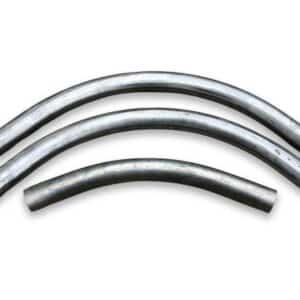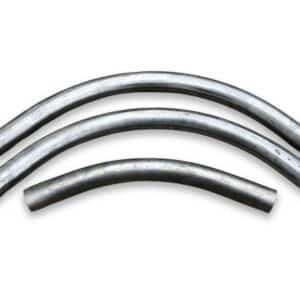Problems like component wear, product degradation, and system pressure drops can seriously reduce the efficiency and cost-effectiveness of your pneumatic conveying system. But while system designers can spend a great deal of time and money trying to resolve these issues, many overlook the simple but impactful role of bend radii.
The different lengths and curvatures of short-radius and long-radius bends affect how your materials move through your pneumatic conveying system. Understanding this relationship empowers you to select suitable components and overcome the challenges keeping you from reaching your productivity potential. So let’s take a look at the differences between short- and long-radius bends, and which would be best for you.
What’s the difference between an elbow and a bend?
When discussing dry bulk materials handling systems, the terms “elbow” and “bend” are often used interchangeably. But while the two are similar, they’re not quite the same. So before we compare short- and long-radius bends, it’s a good idea to highlight the difference between an elbow and a bend.
In short, a “bend” refers to any component that changes the flow direction of materials. But while all elbows are bends, not all bends are elbows. The biggest difference between the two is the radius of curvature.
Elbows typically have a radius of curvature that’s one or two times the pipe diameter. Their sharp corners cause flow direction to change abruptly.
In contrast, bends usually have a radius of curvature that’s more than twice their pipe diameter. This gives them a longer centerline radius and a much smoother curve, leading to a more gradual change in flow direction.
Short-radius bends
Dimensions
A short-radius bend typically has:
- A radius of curvature of about 1.0x the nominal diameter of the pipe
- A length of 3-7x the radius of curvature
- A centerline radius of 2.5-4x the outer diameter
These dimensions give short-radius bends a much sharper turn and change in flow direction.
Benefits
- Affordable: Since short-radius bends are smaller, they require less material to manufacture. This makes them less expensive than long-radius bends
- Easy to install: Short-radius bends are very easy to install and replace. That means you experience less downtime when swapping out components
- Compact: The sharp change in flow direction caused by a short-radius bend means you can design a more compact system. This is particularly useful for facilities with limited space
Drawbacks
- Greater blowout risk: Short-radius bends typically bear the force of conveyed materials in a single spot. When conveying heavy or abrasive material, this can increase the risk of component blowout. In these cases, you might end up spending more on replacement components. (This isn’t a problem when conveying soft materials)
- Higher product degradation: Similarly, the greater force of impact can increase product degradation. This lowers the quality of your product and reduces the amount you can sell
Long-radius bends
Dimensions
A long-radius bend typically has:
- A radius of curvature of about 1.5x the nominal diameter of the pipe
- A length of 8-14x the radius of curvature
- A centerline radius of 10x or greater than the outer diameter
As such, long-radius bends offer a more gradual change in flow direction.
Benefits
- Long-lasting: The gentle change in direction means materials drag along the back of the pipe rather than impact a single point. This reduces component wear, as well as replacement and maintenance costs
- Maintains product quality: Similarly, the lack of a single impact point reduces product degradation. That means you maintain high product quality and can process a greater amount of salable product
- Suitable for fluids: Long-radius bends create less frictional resistance to fluids compared to short-radius bends
Drawbacks
- Tough to predict blowouts: Products that bounce can create multiple points of wear within a long-radius bend. This makes it difficult to predict and plan for component blowout, which could lead to unexpected downtime. (This doesn’t apply when transporting lighter particles)
- Can damage small particles: The increased drag along the back of the pipe actually increases product degradation when transporting small particles or those that smear or create streamers
Keep Reading: Guide to Selecting Pneumatic Conveying Bends
Short-radius vs long-radius bends: Which should you use?
In general, long-radius bends are the more practical choice for pneumatic conveying. While their larger size makes them more expensive, they tend to be more resistant to wear and help maintain product quality. That means you can keep downtime and maintenance costs low while maximizing your profitability.
However, these benefits don’t typically apply when conveying small particles. In such applications, short-radius bends are often the better choice. Similarly, if you have very limited space in your facility, short-radius bends allow you to design a much more compact system.
Get industry-leading custom bends online with PneuComponents
Most component retailers still ask you to complete a lengthy sales process just to order replacement parts. But with PneuComponents, you can order durable, high-performing, cost-effective bends in custom sizes and materials in less than five minutes.
Visit our online store to place your order now.
As a part of Progressive Products, Inc, PneuComponents draws on over 40 years of technical expertise and industry innovation to give you the best possible guidance and service. Progressive Products is an industry-leading manufacturer of abrasion-resistant components, and their products are used in pneumatic conveying systems worldwide.
-
Stainless Steel Bends$0.00 – $2,989.43
-
Product on saleCarbon Steel Bends$15.87 – $746.06
-
Aluminum Bends$9.96 – $246.75



